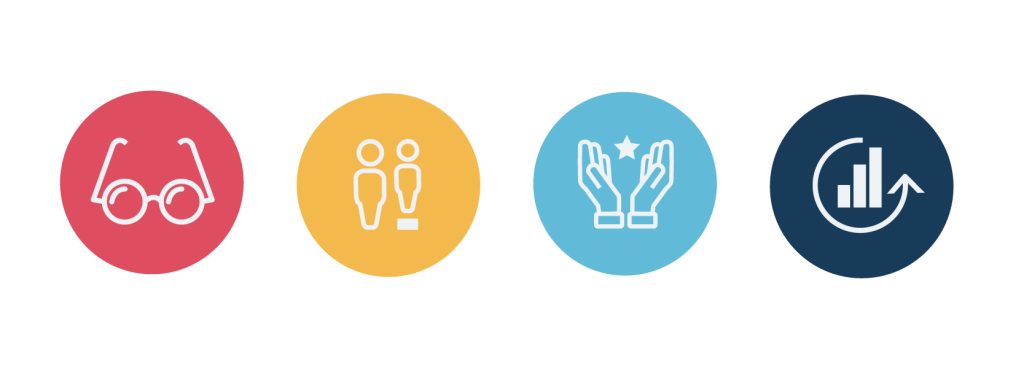Last month we shared a look back and a look ahead for JumpRope. Jesse and Justin spent some time talking with me about what they see as deeply relevant in JumpRope’s past and how they envision that past shaping our future. They detailed some things they hold firmly to, like a commitment to making learning more meaningful for students, new product developments that are generalizable across clients, building from success stories, and the profound commitment of our JumpRope team. All of those things are impacted and in some cases, built on, our company values and beliefs. We thought as we move forward with this year’s blog post series, in addition to sharing the look back, and the look ahead, it might be good to share those values and beliefs. Everything we do at JumpRope is guided by them.
Clarity
When we think about clarity, we think of teachers who are clear about the learning goals in their schools and classrooms, forthcoming in how those goals will be assessed, and generous with students in guiding them toward those goals. Students should not wonder or be confused about what they are being asked to learn or how well they are doing as they move toward being evaluated. And so, educators should articulate desired academic, content-driven outcomes, and also those that address habits or behaviors that support learning. Educators should strive to help students know how their understanding ultimately will be evaluated and support them on their journey by providing descriptive feedback that is specific, timely, actionable, and contributes to student learning. That is, educators should make clear to students what the goal is, how they are doing along the way, what their next steps should be, and how they will be assessed. Lastly, with respect to clarity, we believe that reporting academic grades as distinct from work habits, and reporting academic progress according to learning outcomes, allows teachers and students to best see exactly what has been learned and where the work remains.
Equity of Opportunity
Since learning demands vary, even within a content area, and since learners certainly vary one to the next, it makes sense for the instructional strategies teachers use and the assessment tools they create to vary. Both should be aligned to the type of thinking being taught and assessed, and both should also reflect the specific needs of learners in the classroom. We should aim for consistency in our assessments; ensuring validity by checking that the assessment tools themselves match the intended targets and that when used from one year to the next and from one classroom to the next, those tools are reliable — they produce consistent results. Reaching for this consistency is best done through collaboration with colleagues. Consistency is the sister to mindfully mapping assessments. Assessment maps help teachers ensure they summatively assess all standards adequately and build formative assessments into the learning arc to effectively support students. That formative assessment should be both specific and actionable, it should guide next steps for instruction and help students set goals. Finally, within equity, it’s imperative to consider “photo albums” as opposed to “snapshots”. We should look at a body of evidence and examine learning over time. Recognizing trends in learning and achievement at the end of the learning cycle is not only more equitable for our students, but it provides us with accurate data.
Learner Agency
Learner Agency is hard to foster, but put in place, it transforms what happens in a classroom. When students know how they are doing relative to learning expectations, see a path to improving, and feel motivated to do so, teachers can do their best work. Developing a classroom where learner agency is central requires that teachers are clear with expectations and they provide structured opportunities and tools to help students self-assess relative to those expectations. Teachers work toward developing capacity within their students to reflect on the expectations, ascertain where they are in their learning, and identify things they need to work. The structure that supports learner agency includes provision of models, timely and descriptive feedback, and the ability for learners to track their own progress. Deliberately working toward learner agency positions students to be self-motivated: to identify the goal they need to meet next, take action to meet that goal and to advocate for themselves.
Continuous Improvement Cycle
The education we provide for our students must respond to the changing and evolving demands we see in our world. To ensure that instruction and curriculum truly meet students’ and society’s needs, teachers and schools should engage in a cycle of continuous improvement. The cycle entails setting goals, planning action, collecting evidence, and evaluating the degree to which goals were met. JumpRope understands that classroom data is invaluable to this process.
The process of evaluating student progress and achievement relative to learning goals is made less subjective and more robust when we use data. As teachers move through the instructional cycle, they should examine diagnostic and formative assessment data (the data they can gather before and during teaching) to see which students need more support and who needs additional challenges. The data is also likely to provide some clues as to which instructional and assessment strategies might best meet the needs of those learners and how to adjust pacing.

Periodic review of classroom and school data allows teachers and administrators to evaluate and revise curriculum and programming. Reviewing and comparing classroom data with standardized assessments and comparing local data from one classroom to the next can inform the revision of targets, common rubrics, and assessment criteria. It can even provide insight into how to position teachers to help one another as the data reveals their areas of expertise. Concerned with return on investments, districts can use classroom data to support decisions regarding the purchase of materials or design of professional development.
The ten years of work with our clients and each other and our active pursuit of making learning more meaningful for students leads us to see exactly what we at JumpRope value most. We believe that when teachers and students are very clear on what needs to be learned, students learn better. When teachers are deliberate in how they teach and knowing who they teach, all students have a genuine opportunity to access the content. That content will be more meaningful and learning will transfer from one situation to the next when students have some control, some self-determination. And all of us, students, teachers, schools, and school districts should always strive to learn, and then learn more, so we can be better at teaching.




